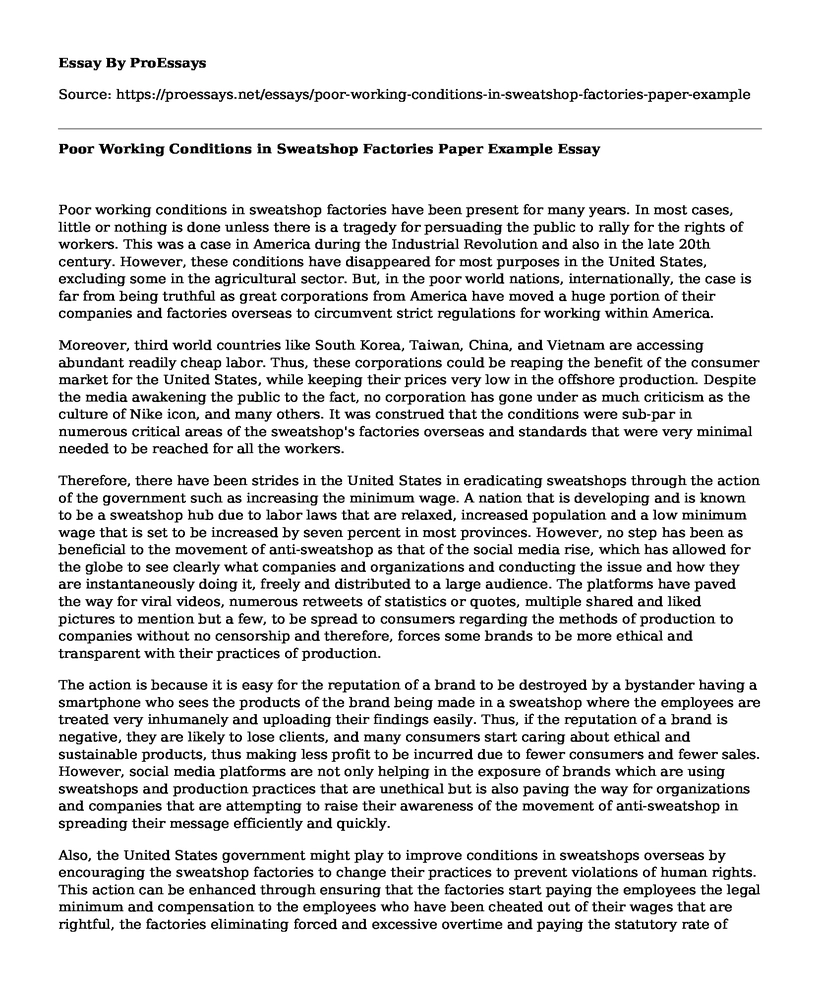Poor working conditions in sweatshop factories have been present for many years. In most cases, little or nothing is done unless there is a tragedy for persuading the public to rally for the rights of workers. This was a case in America during the Industrial Revolution and also in the late 20th century. However, these conditions have disappeared for most purposes in the United States, excluding some in the agricultural sector. But, in the poor world nations, internationally, the case is far from being truthful as great corporations from America have moved a huge portion of their companies and factories overseas to circumvent strict regulations for working within America.
Moreover, third world countries like South Korea, Taiwan, China, and Vietnam are accessing abundant readily cheap labor. Thus, these corporations could be reaping the benefit of the consumer market for the United States, while keeping their prices very low in the offshore production. Despite the media awakening the public to the fact, no corporation has gone under as much criticism as the culture of Nike icon, and many others. It was construed that the conditions were sub-par in numerous critical areas of the sweatshop's factories overseas and standards that were very minimal needed to be reached for all the workers.
Therefore, there have been strides in the United States in eradicating sweatshops through the action of the government such as increasing the minimum wage. A nation that is developing and is known to be a sweatshop hub due to labor laws that are relaxed, increased population and a low minimum wage that is set to be increased by seven percent in most provinces. However, no step has been as beneficial to the movement of anti-sweatshop as that of the social media rise, which has allowed for the globe to see clearly what companies and organizations and conducting the issue and how they are instantaneously doing it, freely and distributed to a large audience. The platforms have paved the way for viral videos, numerous retweets of statistics or quotes, multiple shared and liked pictures to mention but a few, to be spread to consumers regarding the methods of production to companies without no censorship and therefore, forces some brands to be more ethical and transparent with their practices of production.
The action is because it is easy for the reputation of a brand to be destroyed by a bystander having a smartphone who sees the products of the brand being made in a sweatshop where the employees are treated very inhumanely and uploading their findings easily. Thus, if the reputation of a brand is negative, they are likely to lose clients, and many consumers start caring about ethical and sustainable products, thus making less profit to be incurred due to fewer consumers and fewer sales. However, social media platforms are not only helping in the exposure of brands which are using sweatshops and production practices that are unethical but is also paving the way for organizations and companies that are attempting to raise their awareness of the movement of anti-sweatshop in spreading their message efficiently and quickly.
Also, the United States government might play to improve conditions in sweatshops overseas by encouraging the sweatshop factories to change their practices to prevent violations of human rights. This action can be enhanced through ensuring that the factories start paying the employees the legal minimum and compensation to the employees who have been cheated out of their wages that are rightful, the factories eliminating forced and excessive overtime and paying the statutory rate of overtime among others. Moreover, that the conditions of sweatshop still exist even in America is enough evidence that the economic incentives for labor violation standards might be compelling to the employers who are facing a competitive threat. The sweatshops' opponents, having recognized the firm's financial incentives of the standards of low labor, have focused on raising the sweated labor costs. Moreover, increased pressure originates from movements of anti-sweatshops where the consumers are targeted. Thus, through the exposure of the producers of sweatshops and encouraging the consumer boycotts, the anti-sweatshops movements focus on raising the cost of exploitative practices of labor. Nevertheless, while the scope of economic punishment of the producers of sweatshops is limited, the empirical evidence depicts that some consumers are willing to increase their prices to support the conditions of labor. Thus, various partnerships and agreements that are specifying detail working conditions that are acceptable have emerged between the organizations of anti-sweatshop and producers representing consumers, both in Europe and America.
Conclusion
Additionally, the government should ensure that the sweatshop factories levy a stiff penalty for monetary on the company that is contracting whenever it goes against the code of conduct. The practice of not making the companies that are subcontracting responsible for the treatment of employees by their managers might only encourage further violations. The organizations often tend to respond well to monetary fines that are severe. Thus, the only action left might be enforcing the code of conduct.
Cite this page
Poor Working Conditions in Sweatshop Factories Paper Example. (2022, Aug 15). Retrieved from https://proessays.net/essays/poor-working-conditions-in-sweatshop-factories-paper-example
If you are the original author of this essay and no longer wish to have it published on the ProEssays website, please click below to request its removal:
- The Color of Justice - Essay Sample
- Essay Sample on Child Abuse and State Reporting Policies
- Sociological Reasons for Increase in Child Poverty in Hong Kong Immigrant Families - Essay Sample
- Essay Example on Overcoming Internal Conflict: A Difficult but Necessary Journey
- Report Paper Sample on QuikTrip's Plan: Investing Heavily in Workforce for Competitiveness
- Admission Essay Sample on MBA Course in Robotics & Automation
- Essay Sample on Electronic Addiction







